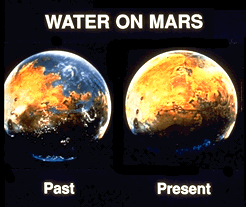 For hundreds of years—perhaps since the times when people realized that Earth is not the center of Universe—humanity has wondered whether there was life on other planets. For some reason, Mars—the planet that is especially easy to notice in the night sky—was always considered to be the most prospective planet in these terms. Scientists, astronomers, science fiction writers, and common people have been excited by the possibility of the existence of life on Mars; these hopes are vastly reflected in modern mass-culture. And what is the most exciting is that these hopes may have a rationale behind them; the most recent astronomical observations show there is flowing water on Mars—and where is water, there is life.
For hundreds of years—perhaps since the times when people realized that Earth is not the center of Universe—humanity has wondered whether there was life on other planets. For some reason, Mars—the planet that is especially easy to notice in the night sky—was always considered to be the most prospective planet in these terms. Scientists, astronomers, science fiction writers, and common people have been excited by the possibility of the existence of life on Mars; these hopes are vastly reflected in modern mass-culture. And what is the most exciting is that these hopes may have a rationale behind them; the most recent astronomical observations show there is flowing water on Mars—and where is water, there is life.

✅ AI Essay Writer ✅ AI Detector ✅ Plagchecker ✅ Paraphraser
✅ Summarizer ✅ Citation Generator
Observing the surface of the Red Planet allows scientists to assume that sometime in the planet’s early history—billions of years ago—it was covered with oceans, and had rivers flowing on its surface. It is considered that Mars was warm and moist enough to host life—not as we would like to imagine life on other planets, since most likely it was some sort of microbial life. However, the problem of the Red Planet is that its mass is lighter compared to Earth, which means its gravity was not strong enough to sustain the atmosphere. Gradually, the water evaporated into the atmosphere, and the atmosphere escaped into space, leaving Mars as the desolate desert we know today (Space.com).
There have been three more rover missions to Mars, including the latest: Curiosity-1. One of their missions was to find evidence that the Red Planet had once been warmer and capable of supporting life. In 2014, the data collected by Curiosity assured scientists there had once been liquid water on Mars. In particular, the analysis of rocks at the bottom of Mount Sharp in the middle of Gale Crater—a 96-mile-wide barren bowl—has demonstrated rather intriguing results: judging from the alternating sediment layers at the base of the mountain, scientists assumed that over the course of millions of years, water flowed on Mars at different levels. Back then, Curiosity scientists suggested that Gale Crater was covered by a large ocean (The Atlantic).
The most revolutionary discovery, however, has been made just recently, on September 28, 2015. NASA has found absolute evidence that there is liquid water on Mars at present. NASA’s Mars Reconnaissance Orbiter identified the presence of perchlorates—hydrated minerals that have formed streaks on slopes on Mars’ surface. Perchlorates—at least some of them—are known to be able to keep water from freezing in extremely low temperatures; for example, -94 Fahrenheit, which is a temperature close to the average one on Mars, is not an obstacle for certain perchlorates to keep water from freezing. During the Mars “hot” seasons, when the temperature on the surface gets around -10 degrees Fahrenheit, perchlorates form streaks—also called recurring slope lineae—on the Martian surface. During the cold season, these lines usually disappear (Wired.com).
According to Lujendra Ojha, one of the project’s researchers, this gives scientists a clearer picture of what water is like on Mars. “Something is hydrating these salts, and it appears to be these streaks that come and go with the seasons. This means the water on Mars is briny, rather than pure. It makes sense, because salts lower the freezing point of water. Even if RSL are slightly underground, where it’s even colder than the surface temperature, the salts would keep the water in a liquid form and allow it to creep down Martian slopes.” Although their team has no clue about where the water comes from, they suggest it might be the underground ice melting, or subterranean streams feeding water to the surface (Wired.com).
Although the recent NASA discovery is not the long anticipated image of water freely flowing on the Martian surface, it has aided scientists in figuring out the truth about water on the Red Planet. Great scientific discoveries rarely look like something fabulous—remember the Newton’s apple, for example—but the form in which these discoveries are made rarely influence the greatness of their outcomes.
References
Fleur, Nicholas St. “The Evolving Search for Life on Mars.” The Atlantic. Atlantic Media Company, 15 Dec. 2014. Web. 29 Sept. 2015.
Redd, Nola Taylor. “Water on Mars: Exploration & Evidence.” Space.com. N.p., n.d. Web. 29 Sept. 2015.
“NASA Discovers Evidence for Liquid Water on Mars.” Wired.com. Conde Nast Digital, n.d. Web. 29 Sept. 2015.
Follow us on Reddit for more insights and updates.





Comments (0)
Welcome to A*Help comments!
We’re all about debate and discussion at A*Help.
We value the diverse opinions of users, so you may find points of view that you don’t agree with. And that’s cool. However, there are certain things we’re not OK with: attempts to manipulate our data in any way, for example, or the posting of discriminative, offensive, hateful, or disparaging material.